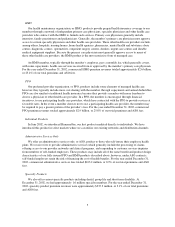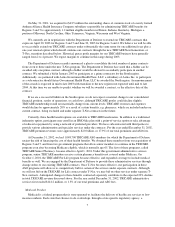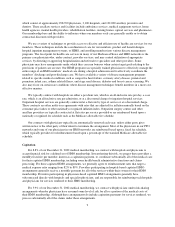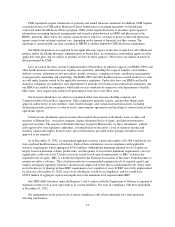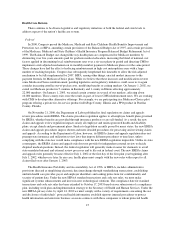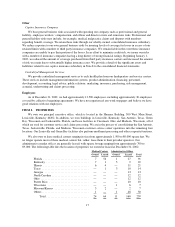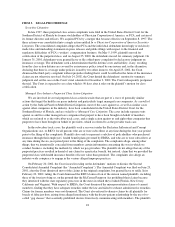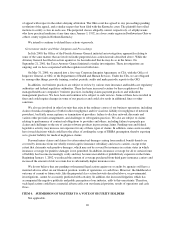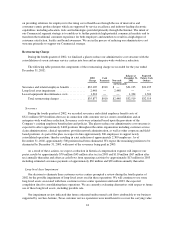Humana 2002 Annual Report Download - page 20
Download and view the complete annual report
Please find page 20 of the 2002 Humana annual report below. You can navigate through the pages in the report by either clicking on the pages listed below, or by using the keyword search tool below to find specific information within the annual report.CMS regulations require submission of quarterly and annual financial statements. In addition, CMS requires
certain disclosures to CMS and to Medicare+Choice beneficiaries concerning operations of a health plan
contracted under the Medicare+Choice program. CMS’s rules require disclosure to members upon request of
information concerning financial arrangements and incentive plans between an HMO and physicians in the
HMOs’ networks. These rules also require certain levels of stop-loss coverage to protect contracted physicians
against major losses relating to patient care, depending on the amount of financial risk they assume. The
reporting of certain health care data contained in HEDIS is another important CMS disclosure requirement.
Our Medicaid products are regulated by the applicable state agency in the state in which we sell a Medicaid
product and by the Health Insurance Administration in Puerto Rico, in conformance with federal approval of the
applicable state plan, and are subject to periodic reviews by these agencies. The reviews are similar in nature to
those performed by CMS.
Laws in each of the states and the Commonwealth of Puerto Rico in which we operate our HMOs, PPOs and
other health insurance-related services regulate our operations, including the scope of benefits, rate formulas,
delivery systems, utilization review procedures, quality assurance, complaint systems, enrollment requirements,
claim payments, marketing and advertising. The HMO, PPO and other health insurance-related products we offer
are sold under licenses issued by the applicable insurance regulators. Under state laws, our HMOs and health
insurance companies are audited by state departments of insurance for financial and contractual compliance, and
our HMOs are audited for compliance with health services standards by respective state departments of health.
Most states’ laws require such audits to be performed at least once every three years.
Our licensed subsidiaries are subject to regulation under state insurance holding company and
Commonwealth of Puerto Rico regulations. These regulations generally require, among other things, prior
approval and/or notice of new products, rates, benefit changes, and certain material transactions, including
dividend payments, purchases or sales of assets, intercompany agreements and the filing of various financial and
operational reports.
Certain of our subsidiaries operate in states that regulate the payment of dividends, loans or other cash
transfers to Humana Inc., our parent company, require minimum levels of equity, and limit investments to
approved securities. The amount of dividends that may be paid to Humana Inc. by these subsidiaries, without
prior approval by state regulatory authorities, is limited based on the entity’s level of statutory income and
statutory capital and surplus. In most states, prior notification is provided before paying a dividend even if
approval is not required.
As of December 31, 2002, we maintained aggregate statutory capital and surplus of $1,006.9 million in our
state regulated health insurance subsidiaries. Each of these subsidiaries was in compliance with applicable
statutory requirements which aggregated $576.0 million. Although the minimum required levels of equity are
largely based on premium volume, product mix, and the quality of assets held, minimum requirements can vary
significantly at the state level. Certain states rely on risk-based capital requirements, or RBC, to define the
required levels of equity. RBC is a model developed by the National Association of Insurance Commissioners to
monitor an entity’s solvency. This calculation indicates recommended minimum levels of required capital and
surplus and signals regulatory measures should actual surplus fall below these recommended levels. Some states
are in the process of phasing in these RBC requirements over a number of years. If RBC were fully implemented
by all states at December 31, 2002, each of our subsidiaries would be in compliance, and we would have
$358.8 million of aggregate capital and surplus above the minimum level required under RBC.
One TRICARE subsidiary under the Regions 3 and 4 contract with the Department of Defense is required to
maintain current assets at least equivalent to its current liabilities. We were in compliance with this requirement
at December 31, 2002.
Our management works proactively to ensure compliance with all governmental laws and regulations
affecting our business.
14



